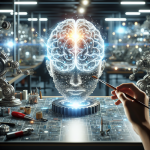
Navigating AI-Powered Language Detection
Embracing AI-Powered Language Detection
Language detection, once a tedious manual task, is now undergoing a remarkable transformation thanks to advancements in artificial intelligence. From translating text to understanding spoken words, AI-powered language detection systems are reshaping how we interact with various platforms and services worldwide. In this article, we’ll explore the key components behind this transformation and its growing implications.
What is AI-Powered Language Detection?
At its core, AI-powered language detection involves using machine learning algorithms to accurately identify languages and facilitate translations in real-time. This approach leverages datasets from millions of language samples, employing neural networks to understand syntax and semantics without the need for extensive human oversight. Here’s how AI tools are also automating reports, further extending AI’s reach.
Key Benefits
- Real-Time Translation: One of the most significant advantages is the ability to deliver real-time translation. For instance, travelers today can communicate effortlessly by using AI translation apps that bridge language barriers instantly.
- Enhanced Accessibility: AI language detection systems make digital content more accessible by providing captions and translating text into multiple languages. This approach increases content reach and ensures inclusivity.
- Adaptability: Modern systems use adaptive learning, improving translations with continued use. Feedback loops allow AI to refine its understanding, moving beyond static models to evolve dynamically with more interaction.
Understanding the Mechanisms
To fully grasp AI-powered language detection, it’s essential to understand the underlying processes. Systems use complex neural networks that mimic human cognitive functions, analyzing and processing language constructs as humans would. These mechanisms perform language identification seamlessly, requiring minimal latency.
Common Applications
- Document and Media Translation: From corporates to educational institutions, AI-driven translation services simplify document handling and media consumption across different languages.
- Customer Support: Businesses enhance customer experience by integrating AI-supported language detection into their support systems, facilitating better interaction with a diverse clientele.
- Content Creation: Content creators may produce multi-language output quickly, ensuring global reach and engagement with a broader audience base.
Challenges and Future Prospects
While AI-driven language detection systems are impressive, challenges remain. Regional dialects, nuanced phrases, and cultural idioms can sometimes elude even advanced AI models, requiring ongoing refinement and training. Despite these challenges, the future of AI in language detection seems very promising. With continuous developments, realistic goals include near-flawless real-time translations and pervasive accessibility enhancements.
Conclusion
AI-powered language detection is a testament to technology’s potential to erase barriers and foster unprecedented connectivity. As we chart a path toward a more inclusive digital future, these tools will remain pivotal in tailoring tailor communication solutions that genuinely resonate across linguistic divides.
Summary Checklist
- Understand the core benefits of AI-powered language detection.
- Explore real-world applications across industries.
- Recognize challenges and envision potential advancements.














